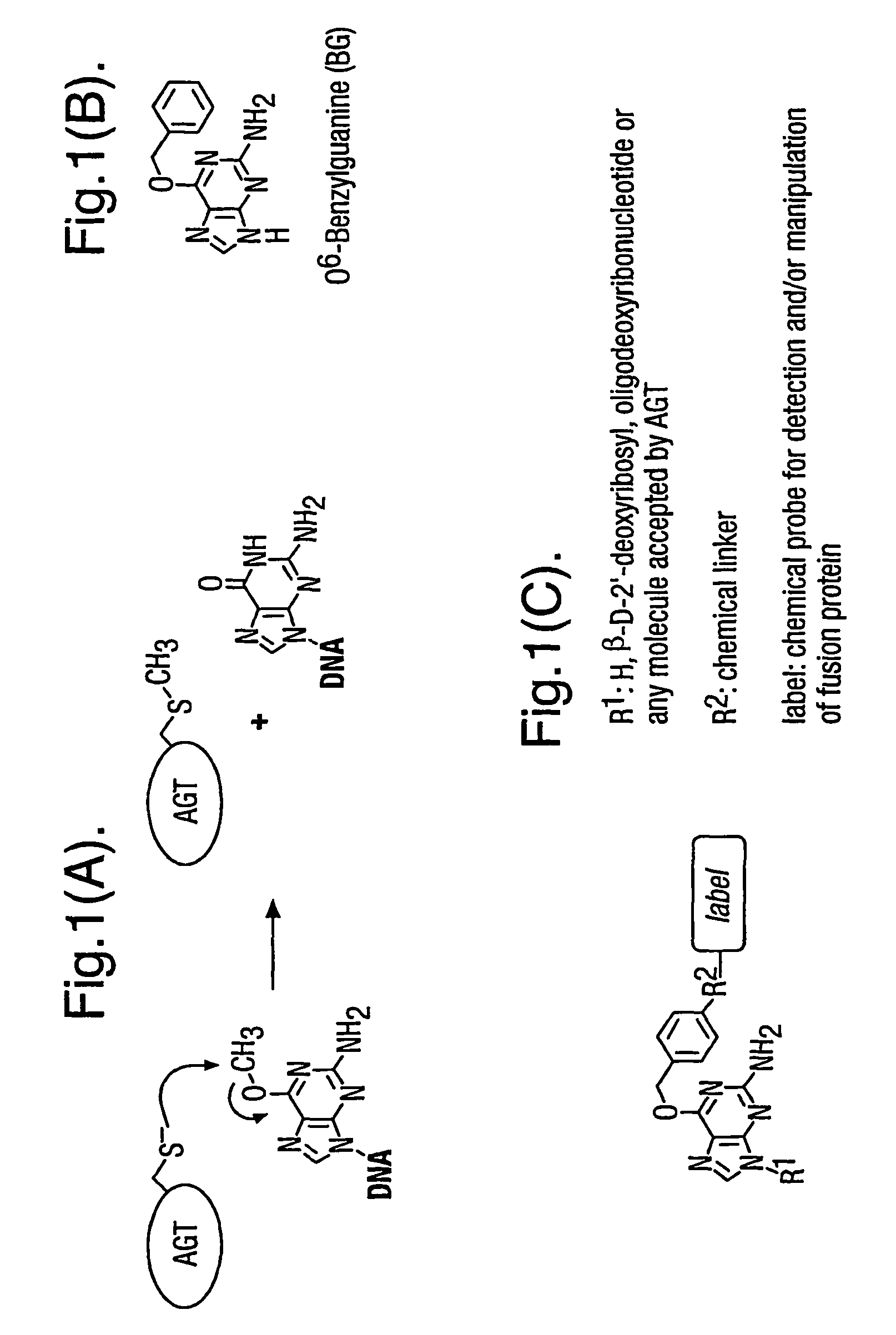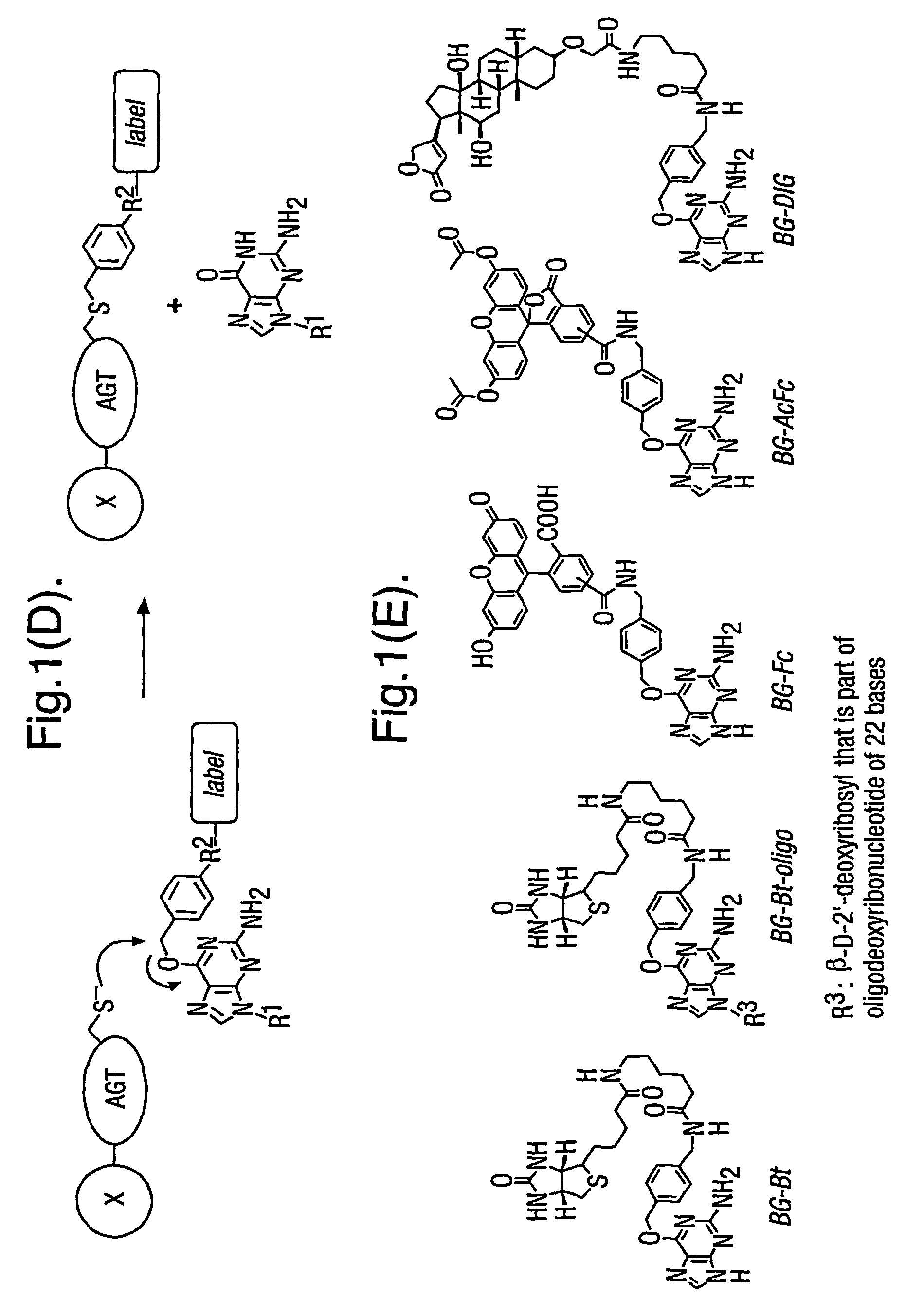Methods using O6-alkylguanine-DNA alkyltransferases
a technology of guaninedna alkyltransferase and o6alkylguaninedna, which is applied in the field of methods using o6alkylguaninedna alkyltransferase, can solve the problems of limited ability to study the behaviour of the corresponding proteins in the living cell, limited ability to characterize multi-protein interactions in vivo and in vitro, and all these techniques have various limitations or disadvantages
- Summary
- Abstract
- Description
- Claims
- Application Information
AI Technical Summary
Benefits of technology
Problems solved by technology
Method used
Image
Examples
examples
[0047]The following examples are set forth so as to provide those of ordinary skill in the art with a complete disclosure and description of how to practice the invention, and are not intended to limit the scope of the invention.
example a
Covalent Labelling of AGT Fusion Proteins in E. coli
[0048]The following example, the labelling of Pep-hAGT in E. Coli using BG-Bt, demonstrates the feasibility of covalently labelling hAGT fusion proteins in E. coli. The sequence of the peptide fused to the N-terminus of hAGT (yielding Pep-hAGT) is (in single letter code) MHHHHHHSSA (SEQ ID NO: 2) followed by the first amino acid of hAGT, a methionine. Liquid cultures of XL-1Blue E. coli cells containing a pET-15b (Novagen) based expression vector encoding hAGT with an N-terminal fusion peptide, i.e. Pep-hAGT, were grown to an optical density OD600nm of 0.6. Expression of Pep-hAGT was induced by adding IPTG to a final concentration of 1 mM. At the same time BG-Bt was added to a final concentration of 10 μM and the bacteria were incubated for 2 h at 37° C. Cells were harvested by centrifugation and the pellet washed twice to remove access BG-Bt. A re-suspended aliquot of cells was analysed by Western Blotting. Biotinylated proteins ...
example b
Covalent Labelling of AGT Fusion Proteins in Yeast
[0049]The following example demonstrates the feasibility of covalently labelling hAGT fusion proteins in yeast. Here, a hAGT-DHFR-HA fusion protein is biotinylation in yeast using BG-Bt. The fusion protein is constructed on the DNA level using standard molecular biology procedures. In short, the stop codon of hAGT is replaced by codons for the amino acids RSGI, which are then followed by the codon for the first amino acid of DHFR from mouse, a Met [Nunberg et al., 1980]. The codons for the linker between hAGT and DHFR also encode for a Bgl II site, its DNA sequence being AGATCT. To construct the fusion between DHFR and the HA tag, the stop codon of DHFR is replaced by a codon for the first amino acid of the HA-tag [Kolodziej, 1991]. The HA-tag is followed by a stop codon. A culture of L40 yeast cells, containing the the expression vector p314AK1 in which the hAGT-DHFR-HA protein is under control of the pcup1 promoter, was grown to an...
PUM
| Property | Measurement | Unit |
|---|---|---|
| Chemical properties | aaaaa | aaaaa |
| Size | aaaaa | aaaaa |
Abstract
Description
Claims
Application Information
 Login to View More
Login to View More - R&D
- Intellectual Property
- Life Sciences
- Materials
- Tech Scout
- Unparalleled Data Quality
- Higher Quality Content
- 60% Fewer Hallucinations
Browse by: Latest US Patents, China's latest patents, Technical Efficacy Thesaurus, Application Domain, Technology Topic, Popular Technical Reports.
© 2025 PatSnap. All rights reserved.Legal|Privacy policy|Modern Slavery Act Transparency Statement|Sitemap|About US| Contact US: help@patsnap.com



